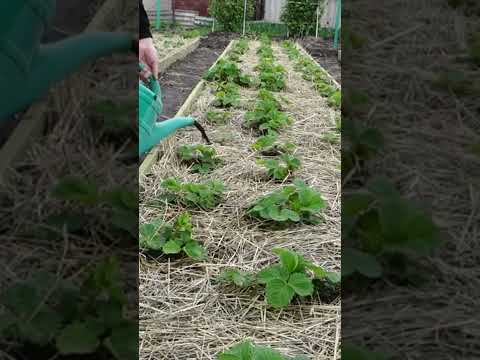Strawberry plants are one of the most popular fruits which are grown in gardens. However, it is important to know what temperature will kill strawberry plants as extreme temperatures can cause damage to the plants and reduce their productivity. In this article, we will discuss the temperatures that can be fatal for strawberry plants and how to protect them from extreme temperatures.Strawberry plants are hardy and can survive in temperatures as low as 20°F. However, temperatures below 10°F can cause damage or even death to the plant.
When Does Cold Temperature Damage Strawberry Plants?
Strawberry plants are quite resilient, but they are still vulnerable to cold temperatures. In general, strawberry plants can tolerate temperatures down to 25°F (-3.9°C), but prolonged exposure to these temperatures can cause significant damage. In particular, the flowers and young fruit of strawberry plants are particularly vulnerable, as they are more sensitive to frost than other parts of the plant. If temperatures dip below 25°F for an extended period of time, the flowers and young fruit will be damaged or destroyed, leading to reduced yields later in the season.
In addition, cold temperatures can also cause damage to the foliage of strawberry plants. Prolonged exposure to temperatures below 32°F (0°C) can lead to leaf discoloration and wilting as well as stunted growth. This type of damage is not usually fatal, but it can reduce yields and make the plant less productive over time.
It is important to protect strawberry plants from cold weather if possible. If you live in an area with cold winters, it is a good idea to cover your strawberry plants with a layer of mulch or plastic sheeting when temperatures dip below freezing. This will help keep your strawberries safe from frost damage and keep them productive for years to come.
How Low Temperature Affects Strawberry Plant Growth?
Low temperatures can be damaging to strawberry plants and can cause poor growth. Cold temperatures can damage the leaves, flowers, and fruit of strawberry plants. The leaves may become discolored or even die off if temperatures stay below freezing for an extended period of time. Flowers may become deformed or fail to open, reducing the number of fruits produced. Fruit that does develop may be deformed or stunted in size from the cold temperatures.
Strawberry plants are hardy and can tolerate short periods of cold, but too much cold will kill them. If temperatures drop below 0°C (32°F) for more than a few hours, the plant may suffer permanent damage. If temperatures drop below -2°C (28°F) for more than a few hours, the plant is likely to die or suffer greatly reduced yield in the current season and possibly future seasons as well.
It is important to protect strawberry plants when there is a risk of freezing temperatures. Covering them with straw or another insulating material helps to keep them warm and reduce the risk of frost damage. Planting in raised beds also helps to protect against cold as it allows warmer air to circulate around the roots. If frost is expected, water your strawberries thoroughly before it arrives as this helps to prevent frost damage by increasing their freezing point slightly.
By taking measures to protect your strawberry plants from low temperatures you can ensure healthy growth and a good harvest each season!
Signs of Cold Damage on Strawberry Plants
Cold weather can cause significant damage to strawberry plants, especially if temperatures drop below freezing. There are several signs to look for that indicate cold damage. The most obvious sign is wilting of the leaves and stems, which is a result of the water inside the plant cells freezing. This can cause the leaves to turn yellow or brown, and they may also become brittle and fall off. In addition, buds may not open up as expected or they may not form properly due to cold damage.
Strawberry plants can also suffer from frost heaving if temperatures fluctuate significantly during the winter months. Frost heaving occurs when soil alternates between freezing and thawing, causing the plant’s root system to be pushed out of the ground. This can stunt growth and prevent new plants from forming properly. It is important to protect strawberry plants from cold weather by using mulch or other insulation around them during winter months.
Finally, severe cold weather can cause dieback in strawberry plants. Dieback occurs when parts of the plant become damaged due to extreme cold temperatures and then die off entirely. This usually happens over a period of time; therefore, it is important to watch for signs such as discoloration or wilting of leaves and buds that could indicate cold damage. If dieback does occur, it is important to remove any dead parts of the plant in order to encourage healthy growth in future seasons.
Prevention of Cold Damage for Strawberry Plants
Strawberry plants are particularly susceptible to cold damage, which can severely reduce the quality and yield of the fruit. To help prevent this, there are several steps that can be taken. The most important is to properly prepare the plants for any cold weather that may come their way. This includes making sure that they are planted in well-drained soil and providing adequate protection from wind and frost. Additionally, providing a thick layer of mulch around the plants can help keep the roots warm during cold temperatures. If possible, it may also be beneficial to cover the plants with a row cover or plastic tarp when temperatures dip below freezing.
In addition to providing protection from cold weather, it is important to ensure that strawberry plants get enough water during periods of extreme heat or drought. This can be done by watering regularly and deeply so that the soil remains moist but not saturated. It is also important to feed the plants with an appropriate fertilizer in order to ensure that they have all the necessary nutrients for optimal growth and fruit production. Finally, it is important to monitor the health of strawberry plants on a regular basis in order to identify any potential problems before they become too severe.
By following these simple steps, gardeners can help ensure that their strawberry plants remain healthy and productive throughout all types of weather conditions. By taking preventive measures before any cold damage occurs, gardeners will be able to enjoy a bountiful harvest of juicy strawberries each year without having to worry about losing their crop due to extreme temperatures or other factors beyond their control.

What to Do When Temperature Drops Below 32 Degrees F for Strawberry Plants?
When the temperature drops below 32 degrees F, it is important to take certain steps to protect your strawberry plants. Strawberries are hardy plants, but extreme cold can cause damage or even death. The best way to ensure the health of your strawberry plants is to take preventative measures before cold weather arrives. Here are some tips for protecting your strawberry plants during cold temperatures:
1. Cover your strawberry plants with a frost blanket or burlap. This will help insulate the plants and keep them protected from extreme temperatures. Make sure the covering is securely tied down so that it doesn’t blow away in strong winds.
2. Mulch heavily around the base of your strawberry plants with straw, hay, or wood chips. This will help retain moisture and provide additional insulation against the cold air.
3. Water your strawberry plants thoroughly before a cold spell arrives. Moist soil retains heat better than dry soil, so this will help protect your plants from extreme temperatures.
4. Bring potted strawberries indoors if possible during a period of very cold weather (below 25 degrees F). Move them back outdoors when temperatures rise above freezing again.
By following these simple tips you can ensure that your strawberry plants remain healthy during periods of extreme cold weather and continue producing delicious fruit for years to come!
Heat Affects the Survival of Strawberry Plants
Heat is one of the most important environmental factors affecting the growth and survival of strawberry plants. Too much heat can damage strawberry plants by causing wilting, reduced yields, and even death. On the other hand, too little heat can also cause poor yields and less vigorous plants. The optimal temperature range for strawberry plants is between 60-75 degrees Fahrenheit (15-24 degrees Celsius).
When temperatures exceed 75 degrees Fahrenheit (24 degrees Celsius), strawberry plants tend to wilt due to lack of moisture in the soil. Additionally, high temperatures can cause flowers to abort and cause fruit to ripen prematurely. This can reduce the overall yield of a strawberry crop. Furthermore, when temperatures exceed 85 degrees Fahrenheit (29 degrees Celsius), it can kill young seedlings and reduce the vigor of established plants.
On the other hand, too little heat can also be detrimental to strawberry plants. If temperatures drop below 60 degrees Fahrenheit (15 degrees Celsius), photosynthesis decreases significantly and will affect plant growth. In addition, temperatures below 50 degrees Fahrenheit (10 degrees Celsius) can cause severe damage or even death to young seedlings or established plants in some cases.
Overall, it is important to maintain optimal temperature conditions for strawberry plants in order for them to survive and produce a good yield. It is recommended that growers monitor temperatures closely during fruiting season so that any sudden changes in temperature will not adversely affect their crop.
Can Hot Weather Kill Strawberry Plants?
Strawberry plants are sensitive to extreme temperatures, so hot weather can have a negative effect on them. In especially hot and dry conditions, strawberry plants can suffer from dehydration, sunburn and heat stress. When this happens, the leaves of the plant will start to wilt and the growth of new flowers and fruits will be inhibited.
Hot weather can also cause damage to the roots of strawberry plants. If the soil is too dry or too hot, it can cause root damage which in turn affects the overall health of the plant. This may result in decreased fertility and overall yield of strawberries.
It is important to monitor your strawberry plants during periods of extreme heat. Make sure they are getting enough water by watering them at least once a day if there is no rain. You should also consider providing some shade for your strawberry plants if possible, as this can help protect them from sunburn and heat stress. Finally, mulching around the base of your strawberry plants will help keep the soil cool and moist which helps prevent root damage from occurring during hot weather.
Overall, while extreme temperatures can have a negative effect on strawberry plants, proper care can help protect them from any potential harm caused by hot weather.

Conclusion
From the above discussion, it can be concluded that strawberry plants are quite cold-hardy and can survive temperatures as low as 20 degrees Fahrenheit. However, temperatures below 15 degrees Fahrenheit will start to cause damage to the plant, and temperatures of 25 degrees or lower will kill them. Therefore, it is important to protect your strawberry plants from frost by using covers or other methods of protection in order to keep the temperature above 25 degrees Fahrenheit.
Overall, strawberry plants are relatively easy to care for and a great addition to any garden. As long as you provide your plants with adequate protection from the cold weather, you should have no problem keeping them healthy and thriving!



